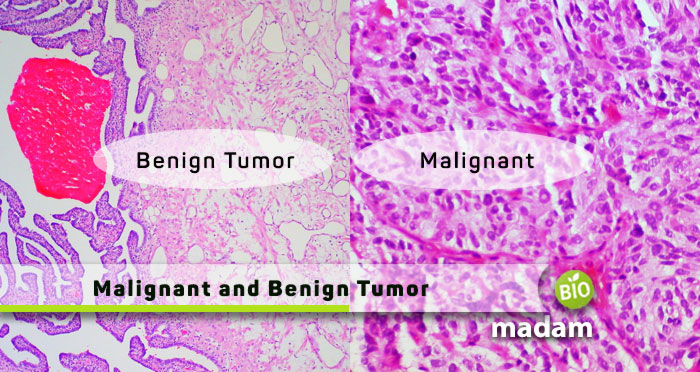Hearing the word tumor gives a thought of something terrible happening to the body. While no tumor can be considered good, some are not lethal. Tumors are painful and can alter your day-to-day activities, and it is important to have them diagnosed at the right time and receive treatment. We have mentioned the differences between malignant and benign tumors to seek care and treatment accordingly.
Comparison Table
| Characteristics | Benign | Malignant |
| Nature of Tumor | Non-cancerous | Cancerous |
| Spread | Do not spread | Adjacent tissues |
| Growth Rate | Slow | High |
| Metastasis | No | Yes |
| Shape | Smooth & regular | Irregular |
| Distinct Boundary | Present | Absent |
| Movement on Pushing | Yes | No |
| Chromosomal Appearance | Normal | The large, & unusual shape |
| Secretions | Absent | Present |
| Fatality | Low | High |
| Treatment | Depends on tumor | Tumor removal |
| Recurrence | Low to none | High |
What is a Tumor?
A tumor, unlike a cyst, is an abnormal growth of cells that continues to grow without the need. Cells multiply rapidly despite signals from the body to stop reproduction. A tumor may be formed due to uncontrolled growth of cells or cells not dying when they should. They take nutrition from their neighboring cells, and the cell may either multiply in that region or spread to other parts of the body.
Tumors are classified as Benign tumors and Malignant tumors depending on their mobility and other characteristics. Understanding the difference between malignant and benign tumors is essential for adequate treatment and care.
Benign Tumors

You may be surprised to know that all benign tumors do not need to be treated. Benign tumors are different from malignant tumors in a way that they do not metastasize. It means that they do not spread to other body parts and are not cancerous. While benign tumors might not require removal in some cases, they should not be overlooked if present in nerves or blood vessels. Benign tumors in the lymphatic or circulatory system are prone to become premalignant.
There are many causes of benign tumors like local injury, trauma, inflammation, environmental toxins, diet, and genetics. One of the major factors contributing to the development of tumors is stress! Make sure to find ways and cope with stress to avoid health disasters. Various types of benign tumors are commonly observed including Adenomas, Fibromas, Lipomas, Hemangiomas, Myomas, Meningiomas, Papillomas, Neuromas, Osteochondromas, and Nevi. They are usually diagnosed through X-ray, Biopsy, CT Scan, MRI, or a Mammogram.
Benign tumors do not require immediate surgical removal, but they may sometimes become malignant. If you experience changes in color, shape, or size of a skin tumor, or headaches, vision issues, or seizures with a diagnosed benign tumor, it is better to report to your doctor. Consistent care is important to ensure that the benign tumor does not turn malignant.
Malignant Tumors

Malignant tumors are cancerous as opposed to non-cancerous benign tumors. They occur due to uncontrolled cell multiplication that spreads to nearby cells and affects other parts of the body. This process is called metastasis. Malignant tumor cells metastasize to different parts of the body and are most common in the brain (causing a decrease in oxygen level), lungs, liver, or bones. They can be diagnosed by using the same diagnostic tests as benign tumors to see if the tumor is cancerous or non-cancerous.
Malignant tumors spread rapidly locally or to distant body regions. The prognosis, diagnosis, and identification of malignant tumors in early stages enable oncologists to prevent the spread of cancer. If undiagnosed, the tumor can spread to other body parts and requires extensive treatment for survival. Tumors diagnosed early can be treated through radiation or chemotherapy, whereas immunotherapy may be needed when cancer has spread. The chances of recurrence of malignant tumors are multiple folds higher.
Premalignant Tumors
Besides benign and malignant, some tumors are termed premalignant tumors. These tumors are non-cancerous benign tumors that have the potential to become cancerous. A premalignant condition may be defined as the increased risk of developing cancer due to a benign tumor.
Difference between Malignant and Benign Tumor
Definition
Benign tumor
Benign tumors are non-cancerous tumors.
Malignant tumor
Malignant tumors are cancerous cells/tumors, caused by any reason, such as radiations.
Spread
Benign tumor
They do not spread to nearby tissues.
Malignant tumor
They can spread to adjacent tissues and invade them.
Growth rate
Benign tumor
The growth rate is relatively slow, and they do not harm neighboring cells.
Malignant tumor
They grow fast and multiply quickly, reaching close cells.
Metastasis
Benign tumor
These tumors do not spread to other parts of the body.
Malignant tumor
They often metastasize and spread to local and distant tissues, sometimes reaching all over the body. They spread through the lymphatic system or bloodstream.
Shape
Benign tumor
Benign tumors usually have a smooth regular shape and can be easily identified.
Malignant tumor
They are uneven and irregular in shape.
Boundary
Benign tumor
Benign tumors have a distinct boundary.
Malignant tumor
Malignant tumors do not present a clear boundary and may reoccur in parts other than the original site.
Movement
Benign tumor
They move around when pushed but do not get carried to other regions.
Malignant tumor
They do not move around and are static when pushed. However, they move to other parts of the body by shedding cells.
Chromosomal appearance
Benign tumor
When studied under a compound, electron, or student microscope, the shape, DNA, and chromosomes of benign tumor cells have a normal appearance.
Malignant tumor
The cells of malignant tumors have abnormal DNA and chromosomes characterized by a large, dark nucleus of an unusual shape.
Secretions
Benign tumor
They do not typically secrete neurotransmitters and hormones or any other secretions.
Malignant tumor
They secrete substances that cause weight loss and fatigue, known as a paraneoplastic syndrome.
Fatality
Benign tumor
Benign tumors are usually not life-threatening. They may become premalignant and need the care to prevent forming of cancerous cells.
Malignant tumor
Malignant tumors can be life-threatening if not diagnosed or treated in time.
Treatment
Benign tumor
They do not need treatment as they are not life-threatening.
Malignant tumor
They need immediate care and adequate treatment to prevent the cancerous cells from spreading and saving the person’s life.
Recurrence
Benign tumor
When removed, benign tumors usually do not come back.
Malignant tumor
The chances of recurrence of malignant tumors are much higher than benign tumors.
The Bottom Line
Tumors can be cancerous or non-cancerous, namely Malignant and Benign. Benign tumors do not metastasize and stay in the originating area, whereas malignant tumors invade neighboring cells and move to other body parts through the blood and lymphatic system. While benign tumors do not need extensive care and treatment, malignant tumors should be treated in the early stage to avoid the spread of cancer disease and fatality.

Anna has completed her degree in Pharmacy from the University of Hawaii. She is serving as a research assistant in a pharmaceutical company. She had a great interest in writing blogs, traveling to different parts of the US, and trying delicious recipes in her spare time.

